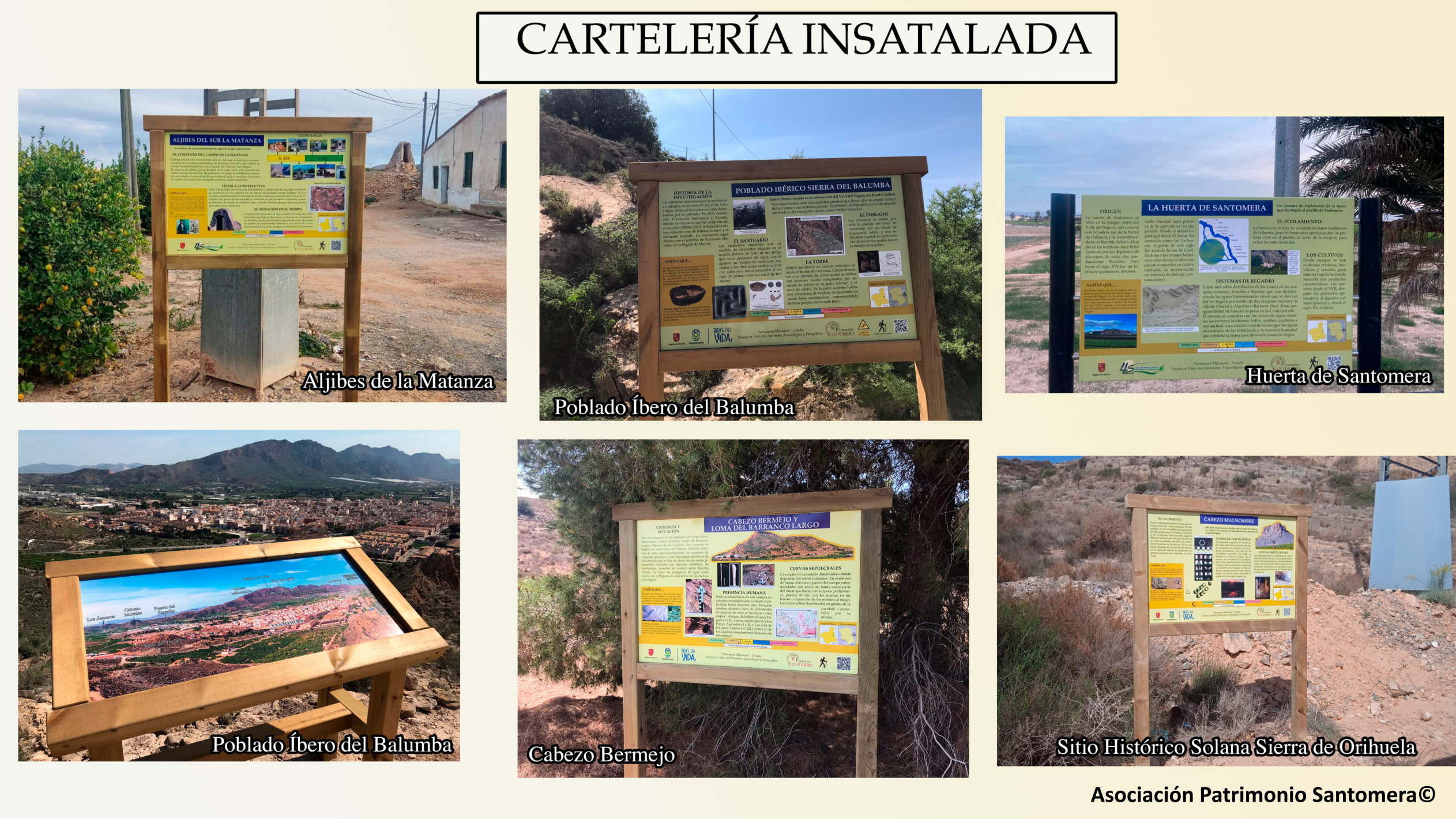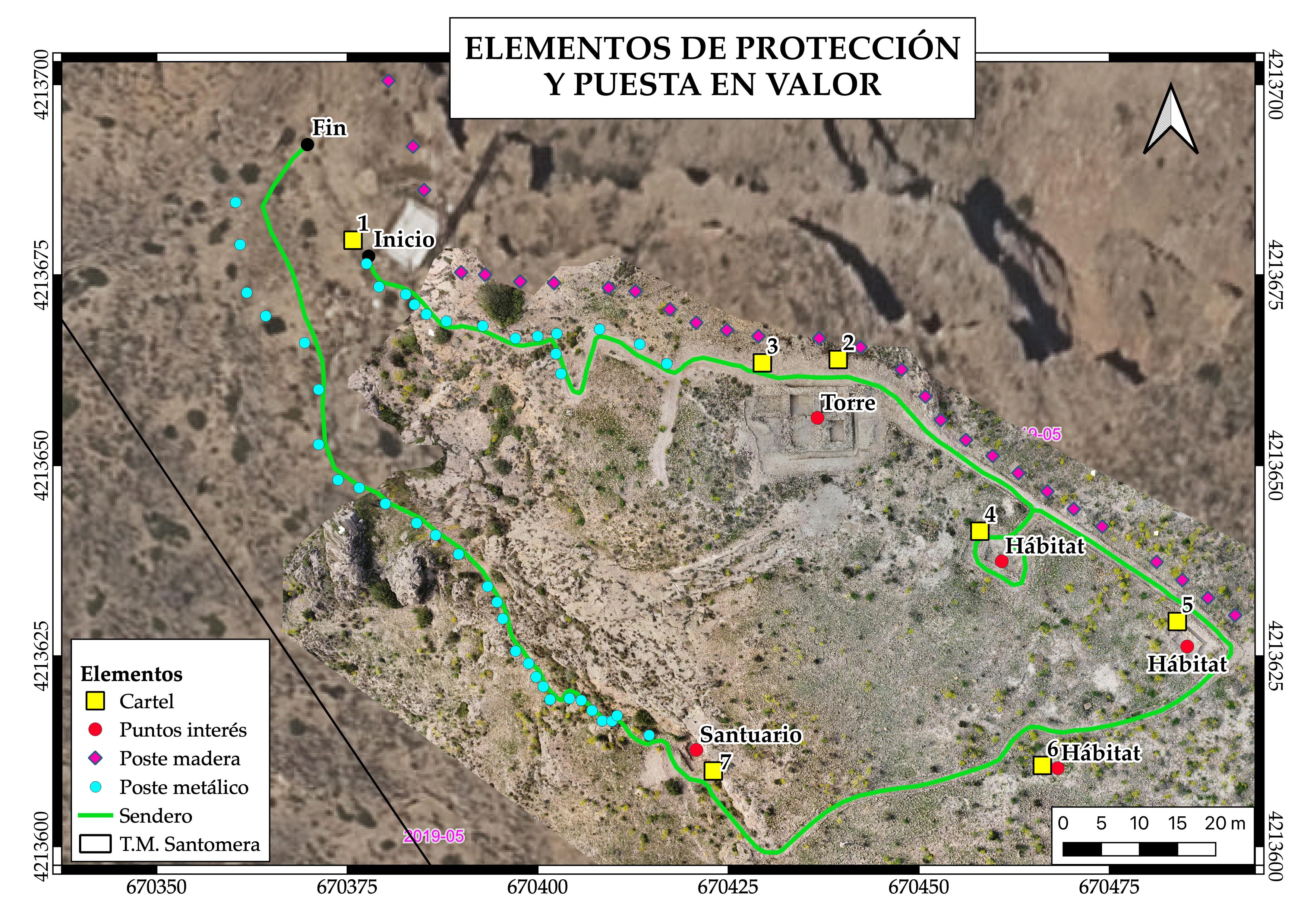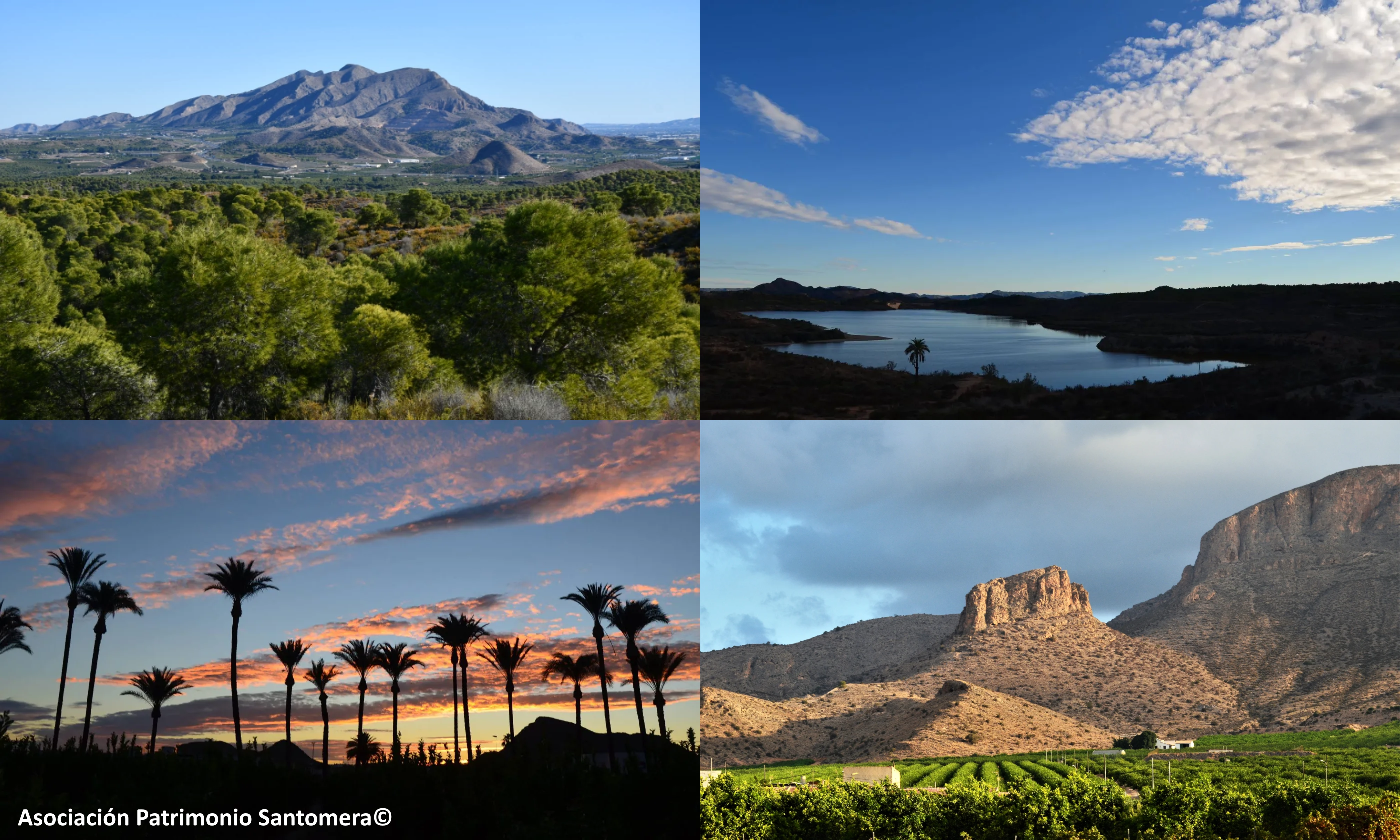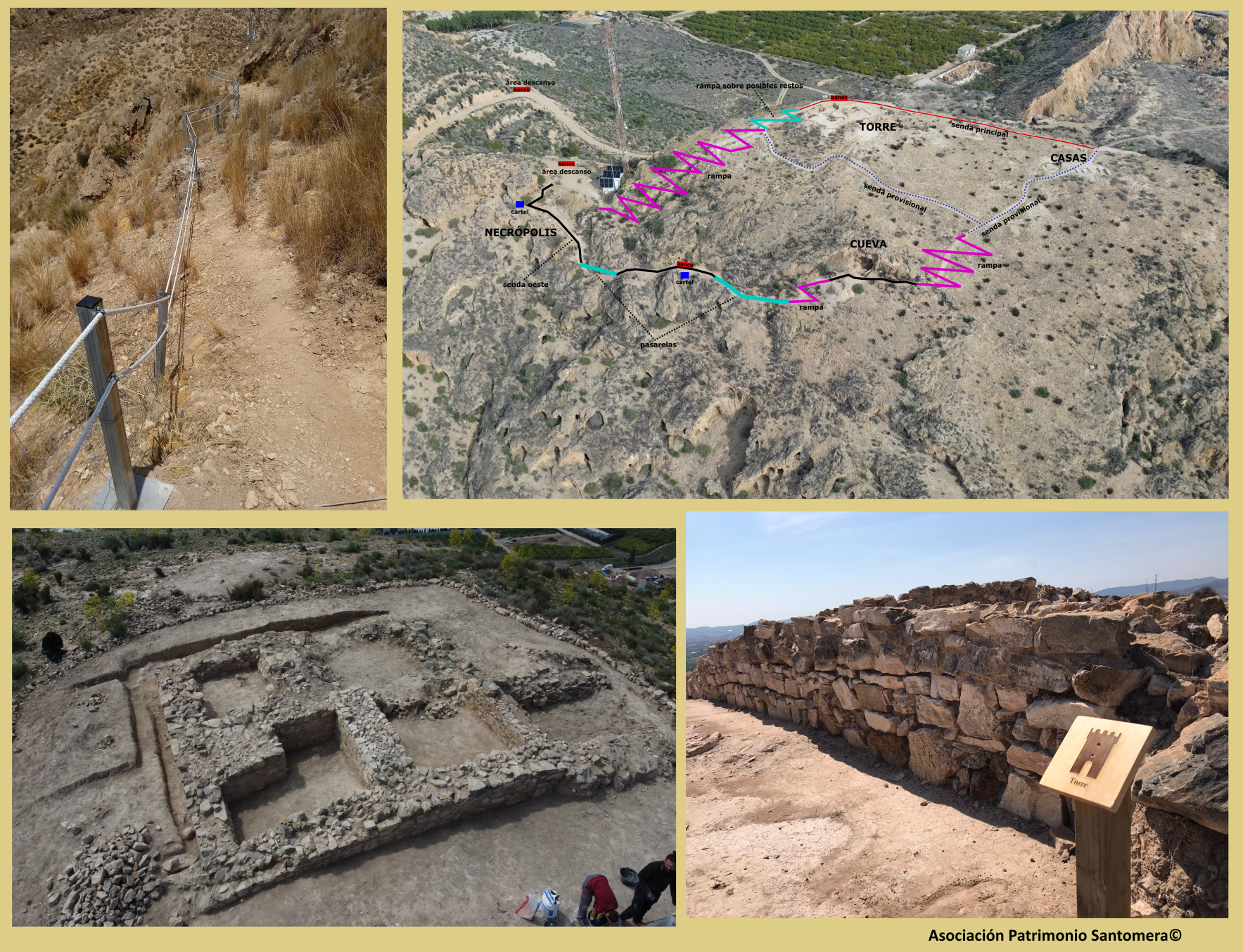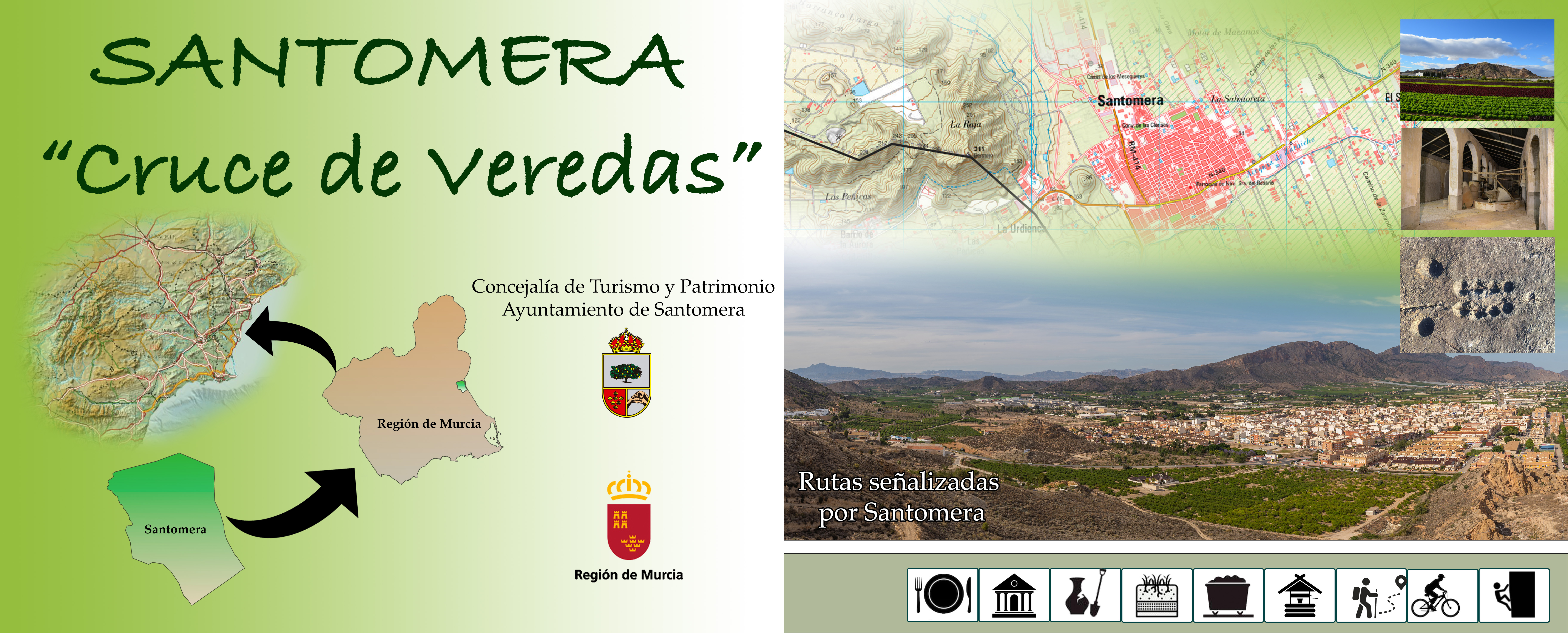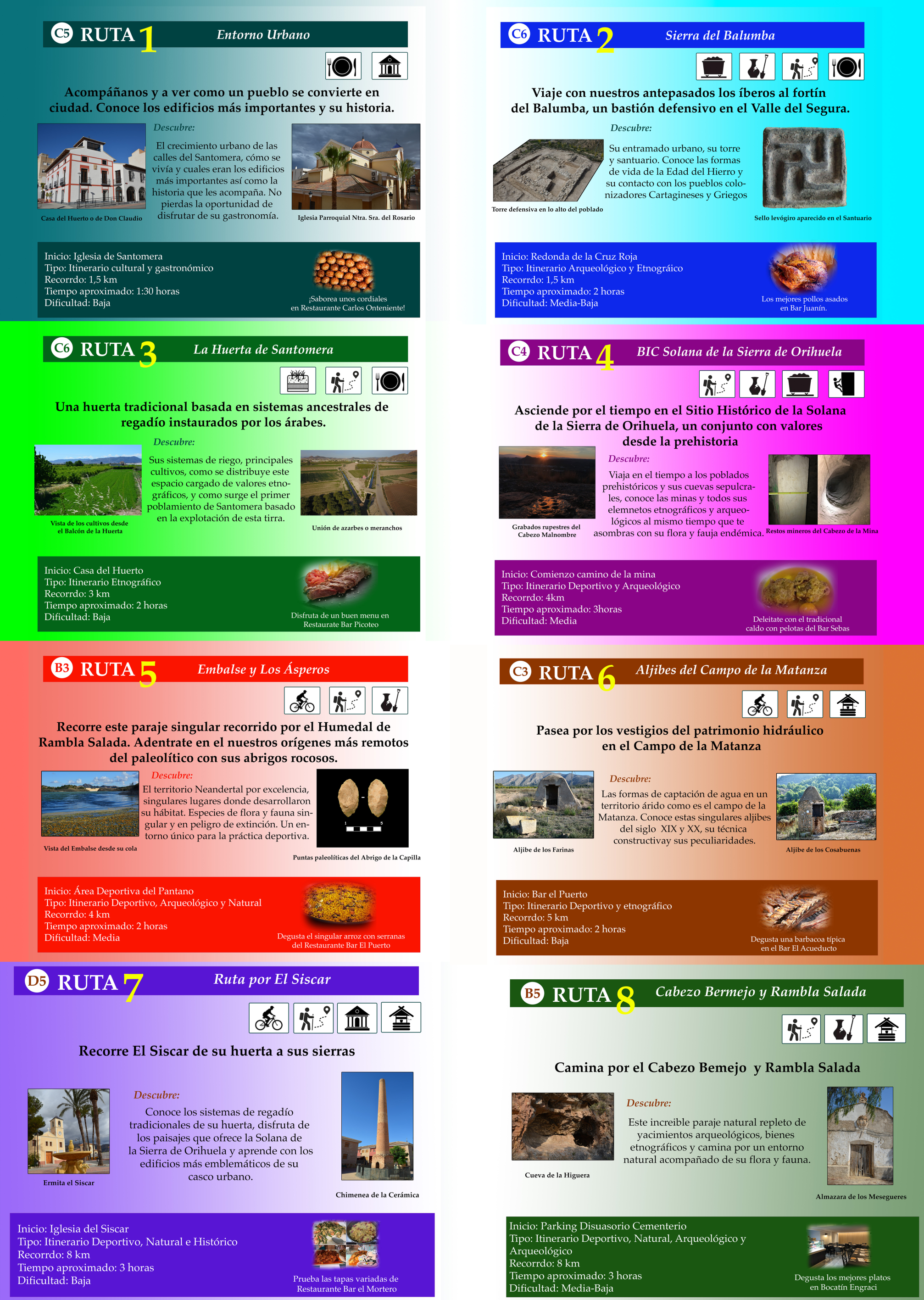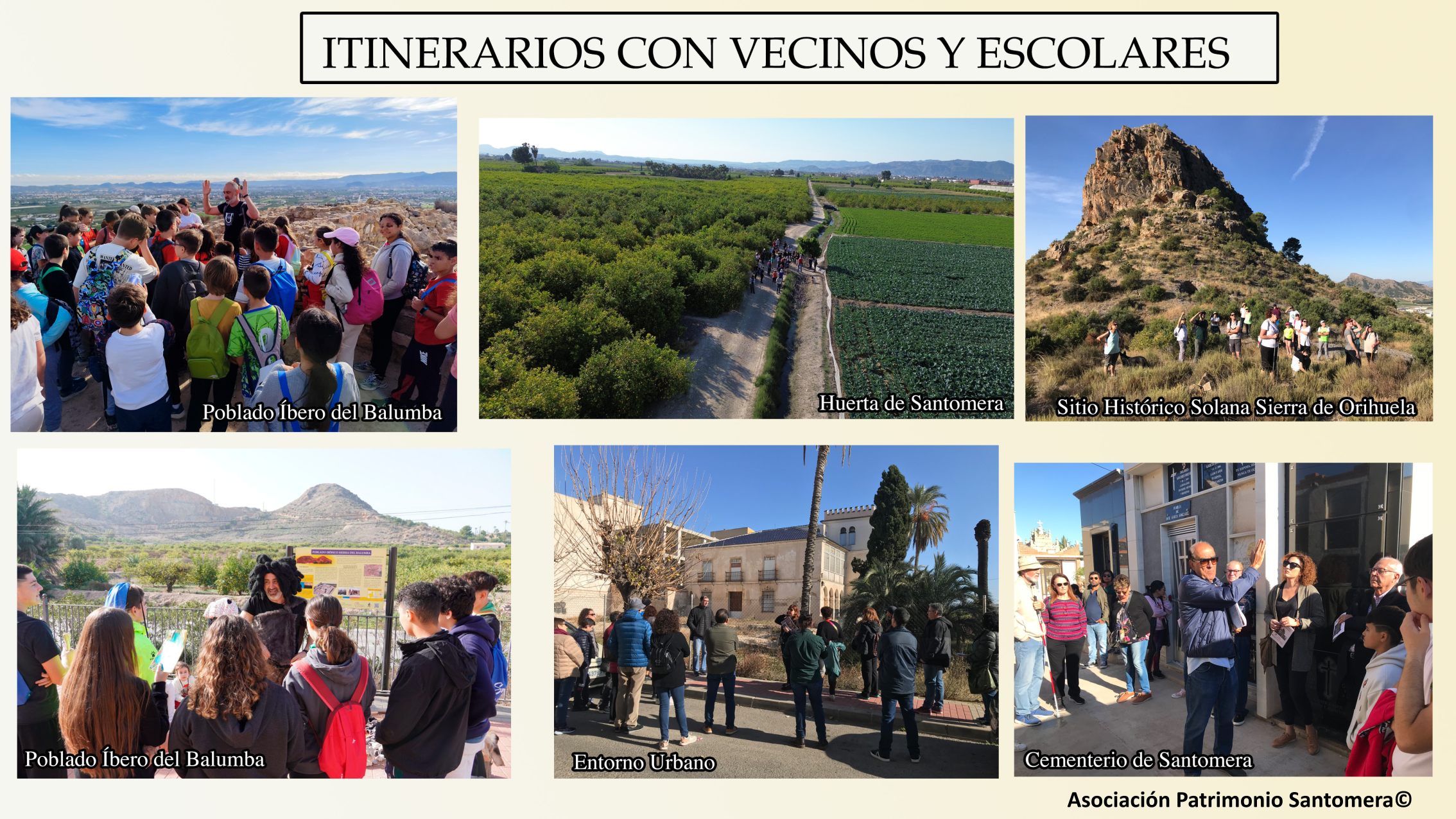"Cruce de Veredas"
'Cruce de veredas': Paths through Santomera to experience the patrimony.
"Cruce de Veredas" is the result of the joint effort between the City Council and various associations in a participative process to empower the local community to hightligh our roots, giving even more visibility to our garden, the Garden of Europe, which represents authentic sustainability cared for to the maximum.
The lovely routes guide you through the wide heritage of Santomera, promoting a sense of belonging through significatives and enjoyables experiences in an inclusive environment.
The lovely routes guide you through the wide heritage of Santomera, promoting a sense of belonging through significatives and enjoyables experiences in an inclusive environment.
Spain
Santomera, Región de Murcia.
Prototype level
Yes
Yes
Yes
No
No
30901: Santomera (ES)
The project proposes an innovative and sustainable approach to enhance the natural, cultural and historical heritage of Santomera by creating accessible itineraries that connect urban centers with spaces of interest. The municipality has an outstanding landscape and heritage wealth, including protected areas and archaeological sites, although part of this heritage is degraded and disconnected from the population due to lack of accessibility and interpretative resources.
The objective is to turn Santomera into a model of sustainability, inclusion and accessibility, where its environment is fully enjoyable for citizens and visitors. This purpose is concreted in the design of thematic routes that promote universal accessibility, sustainable tourism and economic and social dynamization. The project is aimed at the entire population, with special attention to vulnerable groups, people with functional diversity, children, young and old, as well as tourists interested in ecotourism, archaeology, history and local traditions.
Specific objectives have been defined that guide the development of the initiative:
Recover and conserve degraded natural and heritage spaces for future generations.
Design accessible itineraries with inclusive signage, rest areas and digital tools to facilitate understanding of heritage.
Promote intergenerational and social connection through routes that integrate sport, education and culture.
Generate local employment in route design, implementation and maintenance.
Raise awareness of the environment and cultural heritage and encourage healthy activities and community links.
This initiative is expected to increase the quality of life of the inhabitants through equitable access to their heritage, strengthen the local economy and promote sustainable tourism. It contemplates the recovery of emblematic spaces with historical and natural value reinforcing biodiversity and the sense of belonging, positioning Santomera as a referent.
The objective is to turn Santomera into a model of sustainability, inclusion and accessibility, where its environment is fully enjoyable for citizens and visitors. This purpose is concreted in the design of thematic routes that promote universal accessibility, sustainable tourism and economic and social dynamization. The project is aimed at the entire population, with special attention to vulnerable groups, people with functional diversity, children, young and old, as well as tourists interested in ecotourism, archaeology, history and local traditions.
Specific objectives have been defined that guide the development of the initiative:
Recover and conserve degraded natural and heritage spaces for future generations.
Design accessible itineraries with inclusive signage, rest areas and digital tools to facilitate understanding of heritage.
Promote intergenerational and social connection through routes that integrate sport, education and culture.
Generate local employment in route design, implementation and maintenance.
Raise awareness of the environment and cultural heritage and encourage healthy activities and community links.
This initiative is expected to increase the quality of life of the inhabitants through equitable access to their heritage, strengthen the local economy and promote sustainable tourism. It contemplates the recovery of emblematic spaces with historical and natural value reinforcing biodiversity and the sense of belonging, positioning Santomera as a referent.
Accessibility
Heritage
Connectivity
Sustainable itineraries
Ecotourism
The ‘Santomera Cruce de Veredas’ project stands out for its comprehensive approach to sustainability, aligning itself with the values of the New European Bauhaus by combining the preservation of the natural and cultural environment with accessible and sustainable infrastructures that promote a respectful coexistence with the environment and biodiversity.
The initiative promotes the recovery and conservation of degraded and disused natural spaces through nature-based solutions, such as reforestation with native species, soil improvement and restoration of habitats for fauna, necessary actions in areas such as the Balumba and Orihuela mountains or the environment of the Reservoir. The routes are designed under circularity and life cycle criteria, using sustainable and local materials and implementing the use of digital tools that enrich the user experience without compromising natural resources. The maintenance of the infrastructure is planned to ensure its durability with materials with low environmental impact and promoting the participation of local companies specialized in environmentally friendly techniques, guaranteeing the preservation of resources and minimizing the long-term impact.
The project promotes sustainable tourism and non-motorized mobility through itineraries that connect urban centers with nearby natural spaces such as the mountains and hillocks, with walking and cycling tours to reduce the carbon footprint. In addition, it promotes environmental education and awareness programs that reinforce local pride and collective responsibility towards the natural and cultural heritage of the municipality. As an exemplary model, Santomera shows how people can preserve their heritage while fostering social inclusion and responding to challenges such as climate change and biodiversity loss. Its replicable and scalable approach positions it as a regional benchmark in sustainability.
The initiative promotes the recovery and conservation of degraded and disused natural spaces through nature-based solutions, such as reforestation with native species, soil improvement and restoration of habitats for fauna, necessary actions in areas such as the Balumba and Orihuela mountains or the environment of the Reservoir. The routes are designed under circularity and life cycle criteria, using sustainable and local materials and implementing the use of digital tools that enrich the user experience without compromising natural resources. The maintenance of the infrastructure is planned to ensure its durability with materials with low environmental impact and promoting the participation of local companies specialized in environmentally friendly techniques, guaranteeing the preservation of resources and minimizing the long-term impact.
The project promotes sustainable tourism and non-motorized mobility through itineraries that connect urban centers with nearby natural spaces such as the mountains and hillocks, with walking and cycling tours to reduce the carbon footprint. In addition, it promotes environmental education and awareness programs that reinforce local pride and collective responsibility towards the natural and cultural heritage of the municipality. As an exemplary model, Santomera shows how people can preserve their heritage while fostering social inclusion and responding to challenges such as climate change and biodiversity loss. Its replicable and scalable approach positions it as a regional benchmark in sustainability.
The project stands out for its focus on creating meaningful experiences that connect people with their natural, historical and cultural environment. The planning of the thematic routes focuses on a design that balances functionality and beauty, promoting an emotional interaction with the local landscape and heritage. Each itinerary combines architectural, historical, natural, and artistic elements that enrich the user experience.
With the recovery for the citizens of degraded areas, places where we find a large number of archaeological vestiges of all times, the aim is to visually improve the space, making it more attractive and welcoming for all. The routes respect and enhance the environment, using local materials and designs that harmonize with the landscape. The incorporation of aesthetically integrated rest areas, careful signage and the enhancement of archaeological or natural sites, seeks to create feelings of peace and connection with these places, enjoying the scenic beauty and the different goods included in each of the places.
The project also celebrates the cultural identity of Santomera taking into account local traditions, popular architecture and the characteristic landscape of the municipality. These initiatives enhance the sense of community, turning the routes into spaces that invite encounter and exchange, based on healthy cultural, educational and sports activities that strengthen community ties and promote a deeper appreciation of the environment.
This idea demonstrates how an approach based on nature, emotions and culture can transform a territory into a living and meaningful space. Its replicable and scalable character makes it a reference for other localities interested in enhancing the quality of life of its inhabitants through enriching, sustainable and culturally valuable experiences, taking advantage of disused heritage resources.
With the recovery for the citizens of degraded areas, places where we find a large number of archaeological vestiges of all times, the aim is to visually improve the space, making it more attractive and welcoming for all. The routes respect and enhance the environment, using local materials and designs that harmonize with the landscape. The incorporation of aesthetically integrated rest areas, careful signage and the enhancement of archaeological or natural sites, seeks to create feelings of peace and connection with these places, enjoying the scenic beauty and the different goods included in each of the places.
The project also celebrates the cultural identity of Santomera taking into account local traditions, popular architecture and the characteristic landscape of the municipality. These initiatives enhance the sense of community, turning the routes into spaces that invite encounter and exchange, based on healthy cultural, educational and sports activities that strengthen community ties and promote a deeper appreciation of the environment.
This idea demonstrates how an approach based on nature, emotions and culture can transform a territory into a living and meaningful space. Its replicable and scalable character makes it a reference for other localities interested in enhancing the quality of life of its inhabitants through enriching, sustainable and culturally valuable experiences, taking advantage of disused heritage resources.
Santomera's project places inclusion at the heart of its proposal, ensuring that people of all ages, abilities and social conditions can fully enjoy the municipality's natural, historical and cultural heritage. The thematic routes are adapted for people with reduced mobility, including accessible signage in visual, tactile and digital formats, and with rest areas designed to ensure the comfort of all users. These actions are adapted to the characteristics of each space, whether urban or natural, with special attention to improving and facilitating transit in mountain areas where archaeological sites that can potentially be revalued are located.
The routes and activities are free, ensuring that their use is affordable for the entire population without economic barriers. At the same time, the project generates local employment, especially among vulnerable groups, by getting involved in the construction, maintenance and management of infrastructures, promoting their integration and economic autonomy. In terms of inclusive governance, the project incorporates the community from its inception through meetings, workshops and participatory consultations, ensuring that actions reflect the needs and aspirations of citizens. This approach fosters a sense of belonging and reinforces the collective commitment to local heritage. In addition, routes and their areas of application can be meeting spaces that can help strengthen social ties, especially in rural and less connected areas.
The approach of this project, integrating citizen participation and economic sustainability with the revaluation of heritage can serve as a source of inspiration to other municipalities as a way to use their own resources to develop inclusive strategies that promote more just and cohesive communities.
The routes and activities are free, ensuring that their use is affordable for the entire population without economic barriers. At the same time, the project generates local employment, especially among vulnerable groups, by getting involved in the construction, maintenance and management of infrastructures, promoting their integration and economic autonomy. In terms of inclusive governance, the project incorporates the community from its inception through meetings, workshops and participatory consultations, ensuring that actions reflect the needs and aspirations of citizens. This approach fosters a sense of belonging and reinforces the collective commitment to local heritage. In addition, routes and their areas of application can be meeting spaces that can help strengthen social ties, especially in rural and less connected areas.
The approach of this project, integrating citizen participation and economic sustainability with the revaluation of heritage can serve as a source of inspiration to other municipalities as a way to use their own resources to develop inclusive strategies that promote more just and cohesive communities.
Citizen participation is a fundamental axis of the ‘Santomera Cruce de Veredas’ project, since it is the first time that it has designed a plan to link urban centres by alternative routes, create routes to visit the areas of interest of the municipality, as well as to value areas with great potential, but whose current condition does not allow citizens to fully benefit from their intrinsic values. Knowing the opinion and needs of citizens has been fundamental to design the project, so that the beneficiaries and affected people are protagonists in their origin, implementation and monitoring.
The dissemination of the actions and plans has brought the population closer to the cultural and natural heritage of the municipality, promoting familiarization with spaces of archaeological and landscape value that are inaccessible. The community has actively participated in guided tours, workshops, educational talks and public consultations such as the participatory budgets that allowed the museumization of the Iberian site of Balumba, the first space intervened for its revaluation. Associations such as ADIS (Association of people with disabilities of Santomera), Patrimonio Santomera and the hiking group El Quijal de la Vieja, together with experts in culture and environment, have contributed to the design of accessible routes and inclusive signage adapted to local needs.
In the future, participation will continue to be encouraged through monitoring committees and volunteer activities, such as reforestation, maintenance of routes and educational events, ensuring the sustainability of the project and strengthening the social fabric. This collaborative approach positions Santomera as a model in the integration of citizens in local initiatives, demonstrating how active participation improves the quality, relevance and sustainability of public projects.
The dissemination of the actions and plans has brought the population closer to the cultural and natural heritage of the municipality, promoting familiarization with spaces of archaeological and landscape value that are inaccessible. The community has actively participated in guided tours, workshops, educational talks and public consultations such as the participatory budgets that allowed the museumization of the Iberian site of Balumba, the first space intervened for its revaluation. Associations such as ADIS (Association of people with disabilities of Santomera), Patrimonio Santomera and the hiking group El Quijal de la Vieja, together with experts in culture and environment, have contributed to the design of accessible routes and inclusive signage adapted to local needs.
In the future, participation will continue to be encouraged through monitoring committees and volunteer activities, such as reforestation, maintenance of routes and educational events, ensuring the sustainability of the project and strengthening the social fabric. This collaborative approach positions Santomera as a model in the integration of citizens in local initiatives, demonstrating how active participation improves the quality, relevance and sustainability of public projects.
The project has involved the participation of multiple stakeholders at different levels, which has allowed for more effective and integrated planning and implementation. At a local level, the Santomera City Council has led the initiative, providing initial funding, logistical support and coordination between key actors. Likewise, the City Council's technical services have intervened in the areas of action, enabling spaces for the correct adaptation of the itineraries.
Citizens have played an essential role through public consultations, workshops and surveys that have allowed the project to be adapted to their needs and expectations. In addition, cultural, sports and environmental associations have contributed with their knowledge of the territory, promoting awareness and the use of the rehabilitated space.
At a regional level, the Autonomous Community of Murcia has been a key player, financing part of the project and providing technical support through specialized organizations in heritage, tourism and sustainability. The involvement of the general directorates of Cultural Heritage and Natural Heritage has been fundamental to undertake the interventions and improvements in the different areas of the project.
Citizens have played an essential role through public consultations, workshops and surveys that have allowed the project to be adapted to their needs and expectations. In addition, cultural, sports and environmental associations have contributed with their knowledge of the territory, promoting awareness and the use of the rehabilitated space.
At a regional level, the Autonomous Community of Murcia has been a key player, financing part of the project and providing technical support through specialized organizations in heritage, tourism and sustainability. The involvement of the general directorates of Cultural Heritage and Natural Heritage has been fundamental to undertake the interventions and improvements in the different areas of the project.
The project integrates multiple disciplines to ensure a comprehensive and balanced approach.Key areas include architecture, engineering, environment, archaeology, education and tourism, all working in synergy to address the needs of the municipality.
We have designed accessible infrastructures that respect the urban and natural environment.Environmental specialists have provided solutions for the restoration of habitats, including reforestation, control of spills and restrictions on motorized access in areas such as the Santomera Reservoir and the Cave of Yeseras, protecting spaces of great ecological value.
Archaeology has played a crucial role in the recovery of cultural heritage, highlighting the musealization of the Balumba site. Experts have collaborated: scientific-academic, public management of heritage, conservation and restoration and dissemination of knowledge.The process includes all stages from research to valorization, presentation of results and implementation of participatory dissemination activities.
In educational field, the project focuses on children and youngs as a priority audience, promoting awareness of the importance of preserving natural and cultural heritage.Collaborations with schools and local associations have made it possible to develop activities that integrate civic and environmental education.
Tourism experts have contributed to the design of routes that balance economic promotion with respect for biodiversity and heritage.These routes consider both the local population and external visitors, adapting to the needs of different groups.
Interaction has been facilitated through multidisciplinary work tables, generating innovative solutions such as inclusive signage and digital tools. This transversal approach, focused on the accessibility and revaluation of spaces, positions Santomera as a replicable model of technical, social and cultural integration, promoting sustainable initiatives in harmony with the environment.
We have designed accessible infrastructures that respect the urban and natural environment.Environmental specialists have provided solutions for the restoration of habitats, including reforestation, control of spills and restrictions on motorized access in areas such as the Santomera Reservoir and the Cave of Yeseras, protecting spaces of great ecological value.
Archaeology has played a crucial role in the recovery of cultural heritage, highlighting the musealization of the Balumba site. Experts have collaborated: scientific-academic, public management of heritage, conservation and restoration and dissemination of knowledge.The process includes all stages from research to valorization, presentation of results and implementation of participatory dissemination activities.
In educational field, the project focuses on children and youngs as a priority audience, promoting awareness of the importance of preserving natural and cultural heritage.Collaborations with schools and local associations have made it possible to develop activities that integrate civic and environmental education.
Tourism experts have contributed to the design of routes that balance economic promotion with respect for biodiversity and heritage.These routes consider both the local population and external visitors, adapting to the needs of different groups.
Interaction has been facilitated through multidisciplinary work tables, generating innovative solutions such as inclusive signage and digital tools. This transversal approach, focused on the accessibility and revaluation of spaces, positions Santomera as a replicable model of technical, social and cultural integration, promoting sustainable initiatives in harmony with the environment.
The project stands out for its innovative approach, integrating accessibility, environmental sustainability and cultural revaluation, aspects that conventional practices usually address in isolation. This proposal goes beyond creating functional infrastructures, transforming spaces into interactive and educational experiences, and, above all, bringing new values and opportunities to the community through the recovery and opening of other recreational areas for the healthy enjoyment of free time.
The initiative adopts a universal design, ensuring inclusive routes for people with functional diversity through adapted trails, signage in tactile and visual formats, and rest areas designed for different needs. This level of accessibility exceeds the usual standards and serves as a model for other municipalities, especially in rural areas, as well as landscape and historical-artistic resources.
The participatory model is another differentiating aspect. From public consultations to workshops and volunteer programs, the local community has been an active part in the planning, implementation and maintenance of the routes that for the moment have been able to materialize. This approach contrasts with conventional practices, where citizens often have a passive role, and ensures that solutions respond to real needs.
Also in the environmental field, the project innovates by restoring degraded habitats, transforming these spaces into sustainable resources that promote biodiversity and add value to the offer of cultural and outdoor activities of the people and the region. These measures contrast with traditional projects, which often prioritize development over conservation.
Santomera Cruce de Veredas redefines the usual practices by combining citizen participation, science, technology and sustainable solutions in a replicable model that connects the natural, the cultural and the human, positioning itself as an innovative reference.
The initiative adopts a universal design, ensuring inclusive routes for people with functional diversity through adapted trails, signage in tactile and visual formats, and rest areas designed for different needs. This level of accessibility exceeds the usual standards and serves as a model for other municipalities, especially in rural areas, as well as landscape and historical-artistic resources.
The participatory model is another differentiating aspect. From public consultations to workshops and volunteer programs, the local community has been an active part in the planning, implementation and maintenance of the routes that for the moment have been able to materialize. This approach contrasts with conventional practices, where citizens often have a passive role, and ensures that solutions respond to real needs.
Also in the environmental field, the project innovates by restoring degraded habitats, transforming these spaces into sustainable resources that promote biodiversity and add value to the offer of cultural and outdoor activities of the people and the region. These measures contrast with traditional projects, which often prioritize development over conservation.
Santomera Cruce de Veredas redefines the usual practices by combining citizen participation, science, technology and sustainable solutions in a replicable model that connects the natural, the cultural and the human, positioning itself as an innovative reference.
The project is developed through a comprehensive and participatory methodology. In initial phase, a territorial diagnosis was made to identify priority areas and specific needs, analyzing natural, cultural and social resources. This process is based on agreements between the city council, universities and local associations, ensuring that the design reflects the expectations of the community. Collaboration between specialists and volunteers made it possible to protect the Sierra de Orihuela as a CIG with the category of Historic Site, marking the beginning of a comprehensive value-added plan. It has intervened in semi-abandoned areas such as the Iberian town of Balumba and the environment of the Santomera Reservoir to reactivate these areas and implement thematic routes.
Actions are developed in several phases, prioritizing strategic interventions that generate immediate benefits: excavation and musealization of the Balumba site, improvement of accessibility in the prehistoric reservoirs of the Reservoir, placement of posters in La Mina, and adaptation of the recreational area of the Reservoir with the restriction of vehicles and the start-up of a shelter. These measures respond to previous studies such as SWOT analysis, which evaluate economic factors, materials and future prospects.
The need to interconnect the areas of the municipality led to the creation of alternative roads for pedestrian and cyclist use in safe conditions. In the first phase, interventions have been prioritized in two routes: the urban and garden environment, continuing to improve the site of Balumba through the participation of associations and volunteers. In parallel, educational and cultural programs are carried out that promote knowledge of heritage from an early age, promoting informative activities and days of popular participation open to all ages. This comprehensive approach ensures balanced and sustainable progress in the recovery of heritage and revitalization of the territory
Actions are developed in several phases, prioritizing strategic interventions that generate immediate benefits: excavation and musealization of the Balumba site, improvement of accessibility in the prehistoric reservoirs of the Reservoir, placement of posters in La Mina, and adaptation of the recreational area of the Reservoir with the restriction of vehicles and the start-up of a shelter. These measures respond to previous studies such as SWOT analysis, which evaluate economic factors, materials and future prospects.
The need to interconnect the areas of the municipality led to the creation of alternative roads for pedestrian and cyclist use in safe conditions. In the first phase, interventions have been prioritized in two routes: the urban and garden environment, continuing to improve the site of Balumba through the participation of associations and volunteers. In parallel, educational and cultural programs are carried out that promote knowledge of heritage from an early age, promoting informative activities and days of popular participation open to all ages. This comprehensive approach ensures balanced and sustainable progress in the recovery of heritage and revitalization of the territory
The project includes elements that can be replicated and transferred to other territories, beneficiaries and contexts, thanks to its integral, methodological and participatory approach. Being a sustainable initiative, little invasive and that does not involve large investments or works. The need to preserve cultural and natural heritage is common in all communities and a project like this can be a good method to integrate this heritage into the daily lives of citizens, including educational work and the promotion of healthy activities. Therefore, the methodology applied can be effectively replicated as a tool that helps to respond to the real demands of the population and its environment.
Design of accessible, interconnected and safe routes is also fully transferable. The implementation of roads that prioritize pedestrian and cycling, along with inclusive signage and adapted rest areas, constitutes a replicable model to promote sustainable mobility and universal accessibility elsewhere. Use of digital tools is an economical and effective solution to expand the scope of the project to different contexts.
Restoration of degraded areas and the musealization of historical sites can be adapted to different scenarios, always prioritizing conservation and community integration. Educational and informative activities, designed to generate awareness and appropriation of heritage from an early age, are also highly transferable, fostering an active and committed citizenship. The inclusive governance model, involving public administrations, universities, local associations and citizens, provides a roadmap that can be carried out in most territories. Likewise, the creation of working groups, monitoring committees and volunteer programs can inspire similar initiatives in other municipalities, ensuring a collaborative and sustainable approach.
Processes, learning and technologies used in this project can be adapted to different contexts, serving as a reference to develop i
Design of accessible, interconnected and safe routes is also fully transferable. The implementation of roads that prioritize pedestrian and cycling, along with inclusive signage and adapted rest areas, constitutes a replicable model to promote sustainable mobility and universal accessibility elsewhere. Use of digital tools is an economical and effective solution to expand the scope of the project to different contexts.
Restoration of degraded areas and the musealization of historical sites can be adapted to different scenarios, always prioritizing conservation and community integration. Educational and informative activities, designed to generate awareness and appropriation of heritage from an early age, are also highly transferable, fostering an active and committed citizenship. The inclusive governance model, involving public administrations, universities, local associations and citizens, provides a roadmap that can be carried out in most territories. Likewise, the creation of working groups, monitoring committees and volunteer programs can inspire similar initiatives in other municipalities, ensuring a collaborative and sustainable approach.
Processes, learning and technologies used in this project can be adapted to different contexts, serving as a reference to develop i
The "Santomera Cruce de Veredas" project addresses global challenges related to environmental sustainability, social inclusion, heritage conservation and sustainable mobility, offering local solutions that can serve as a model for other territories. One of the main global challenges it faces is the environmental crisis and the loss of biodiversity. The project responds to this challenge by protecting and restoring degraded natural environments. Actions such as reforestation, cleaning up spills and restricting motor vehicles contribute to preserving habitats and fostering ecological resilience. These local measures generate global impact by mitigating the effects of climate change and conserving essential natural resources.
Another key challenge is the growing disconnect between communities and their natural and cultural environment. The initiative promotes the valorization of local heritage, both historical and environmental, through the museumization of archaeological sites and the creation of accessible thematic routes. This not only preserves cultural identity, but also promotes education and sustainable tourism, integrating the population in the care of their heritage. The project also addresses the lack of inclusive and sustainable mobility, a common problem in many urban and rural areas. Interconnecting urban and rural centres through safe routes for pedestrians and cyclists reduces car dependency and promotes healthy habits, contributing to global decarbonisation goals and more sustainable cities.
In social terms, the initiative responds to the challenge of inequality and exclusion through an inclusive approach. It guarantees universal accessibility in infrastructures and activities, involving diverse groups in the design, execution and maintenance of routes. This model fosters social cohesion, citizen participation and the generation of local opportunities, contributing to more equitable societies.
Another key challenge is the growing disconnect between communities and their natural and cultural environment. The initiative promotes the valorization of local heritage, both historical and environmental, through the museumization of archaeological sites and the creation of accessible thematic routes. This not only preserves cultural identity, but also promotes education and sustainable tourism, integrating the population in the care of their heritage. The project also addresses the lack of inclusive and sustainable mobility, a common problem in many urban and rural areas. Interconnecting urban and rural centres through safe routes for pedestrians and cyclists reduces car dependency and promotes healthy habits, contributing to global decarbonisation goals and more sustainable cities.
In social terms, the initiative responds to the challenge of inequality and exclusion through an inclusive approach. It guarantees universal accessibility in infrastructures and activities, involving diverse groups in the design, execution and maintenance of routes. This model fosters social cohesion, citizen participation and the generation of local opportunities, contributing to more equitable societies.
The project advances in its implementation integrating the principles of the New European Bauhaus. Its activities include the recovery of natural and cultural spaces, the creation of accessible routes and environmental and heritage education, with an approach that prioritizes ecological regeneration, cohesion and collective enjoyment.
Sustainability is embodied in actions such as the regeneration and preservation of sensitive habitats and the promotion of non-motorized forms of mobility, respecting the limits of the natural environment. Beauty is reflected in the design of routes that not only connect spaces, but reactivate their cultural and landscape value, generating significant experiences that strengthen the local identity. In addition, citizen participation ensures that interventions are inclusive, accessible and adapted to the real needs of the community.
Inclusiveness values guide collaboration between associations, experts and citizens, promoting equality and fostering a participatory governance model. The creation of digital tools to interpret heritage and the organization of workshops, volunteering and educational days ensure that all social groups can be part of the process, enriching the community fabric.
In the future, the project plans to expand its thematic routes, implement inclusive signage, complete the enhancement of potential areas and consolidate continuous citizen participation. This approach will not only transform the local territory, but also lay the foundations for a replicable model, demonstrating how the combination of sustainability, inclusion and aesthetics can drive a new way of respectful coexistence with the environment.
Sustainability is embodied in actions such as the regeneration and preservation of sensitive habitats and the promotion of non-motorized forms of mobility, respecting the limits of the natural environment. Beauty is reflected in the design of routes that not only connect spaces, but reactivate their cultural and landscape value, generating significant experiences that strengthen the local identity. In addition, citizen participation ensures that interventions are inclusive, accessible and adapted to the real needs of the community.
Inclusiveness values guide collaboration between associations, experts and citizens, promoting equality and fostering a participatory governance model. The creation of digital tools to interpret heritage and the organization of workshops, volunteering and educational days ensure that all social groups can be part of the process, enriching the community fabric.
In the future, the project plans to expand its thematic routes, implement inclusive signage, complete the enhancement of potential areas and consolidate continuous citizen participation. This approach will not only transform the local territory, but also lay the foundations for a replicable model, demonstrating how the combination of sustainability, inclusion and aesthetics can drive a new way of respectful coexistence with the environment.

